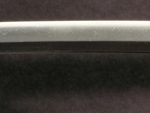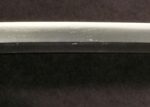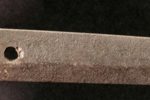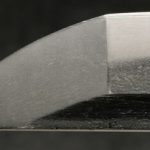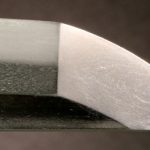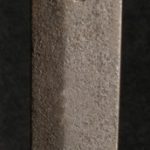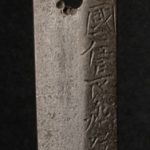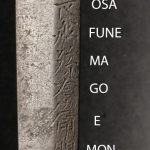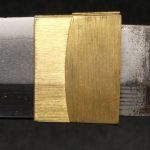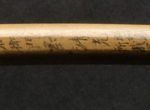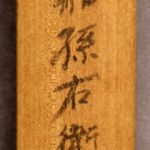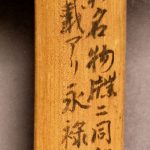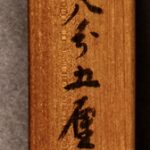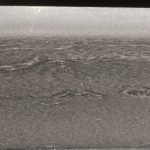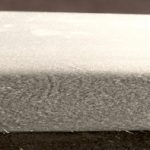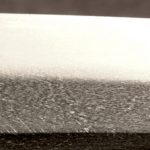BIZEN Mago ́emon KIYOMITSU / $5500
BIZEN KIYOMITSU
KATANA
SUGATA: SHINOGI ZUKURI
ZOKUMYO MEI: BIZEN no KUNI JU Mago ́emon JO KIYOMITSU
DATE: NONE worked c. 1558
FUJISHIRO QUALITY RATING: JOSAKU
KOKIN KAJI BIKOSEN SHARPNESS/CUTTING RATING: O-WAZAMONO
NAGASA: 66.04cm (26″)
OVERALL: 83.50cm (32.875″)
MIHABA: 3.016cm (1.1875″)
KASANE: 0.63cm (0.25″)
SORI: 1.905cm (0.75″)
NAKAGO: UBU
MEKUGI ANA: TWO
YASURIME: KIRI
MUNE: IORI
HADA: ITAME with MASAME
HAMON: SUGUBA
BOSHI: KOMARU
HORIMONO OMOTE: NONE
HORIMONO URA: NONE
HABAKI: TWO PIECE GOLD FOIL
SHIRASAYA with SAYAGAKI
BIZEN MAGOUEMON KIYOMITSU
Bizen Magouemon Kiyomitsu, c. 1558 was a Sue-Koto smith who work in the late Muromachi era. According to the literature, Magouemon Kiyomitsu is a representative smith of this period. He and Gorouzamon Kiyomitsu were the two best smiths within the Sue-Bizen group.
Magouemon excelled in forging suguha and his blades were known for their superior cutting ability. Due to their cutting ability his works are documented and rated O-wazamono according to Yamada Asuemon Yoshichika’s, Kokin Kaji Bikosen.
Magouemon is rated Josaku by Fujishiro for quality. It is well known any smith listed in Fujishiro’s is far above average in quality.
One hundred years of the Muromachi period (1392-1596) fell within the Sengoku Jidai or warring period of 1467-1615. During this time of war, many swords were required by the various regimes resulting in their mass production. These mass-produced swords are known as Kazuuchi-mono which literally means “made in large numbers”. They were also referred to as tabagatana or “bundle swords”.
Chumon-uchi, a term developed to distinguish between the mass produced kazuuchi-mono and the higher quality swords. Chumon-uchi literally meaning the opposite of kazuuchi-mono or, “made to order” opposed to mass produced.
Chumon-uchi were also signed using the smiths common or first name such as Magouemon. This type of mei is known as Zokumyo or Zokumyo-iri, a term indicating the mei contains the first name of the smith and is Chumon-uchi.
While this is technically a Katana, I can’t help but wonder if it was made as an Uchi-gatana. Fully understanding the uchi-gatana is challenging as it changed drastically over time. Following is a condensed version of its history. Like various other styles, the uchi-gatana fell in and out of fashion. Originally, it was a weapon for low-ranking warriors but later became en vogue with Daimyo as well as high ranking Bushi and merchants. When the uchi-gatana first emerged in the Kamakura period it was closer in length to ko-wakizashi or tanto with a nagasa length of around 12”-15” and most were mounted in the aikuchi style. By the Muromachi period they had become longer with a nagasa of around 23”-26”. Also, by this time they were mounted as we think of katana and wakizashi, that is with tsuba, and wrapped tsuka.
Nice example made by one of the two best Bizen smiths of the period.
It is signed Zokumyo mei and is Chumon-uchi.
The sword is housed in shirasaya with Sayagaki.
The sayagaki states:
Bizen no Kuni Ju Osafune Magouemon No Jo Kiyomitsu
Shōwa Meibutsu Chō ni dōmei shosai ari, Eiroku goro (A blade with the same mei is featured in the Shōwa Meibutsu Chō. Dates around Eiroku (1558–1570). (Shōwa Tōken Meibutsu Chō that was published by Murakami Kōsuke in 1979)
Last section is the nagasa.
Followed by a Kao.
*This kao doesn’t match any of the known scholars typically seen on shirasaya. I can only conclude that it was the kao of a private collector or perhaps a shop owner.
SOLD
If you are interested in owning this sword, contact me via the website or directly at yakiba.com@gmail.com
